-
Posts
981 -
Joined
-
Last visited
Content Type
Profiles
Blogs
Forums
American Weather
Media Demo
Store
Gallery
Posts posted by Vergent
-
-
I was disappointed that there was not more discussion about Arctic Methane Emergency Group.
http://www.arctic-me...ders/4558749249
It certainly lays to rest the notion that the article in the Independent was a tabloid exaggeration.
There is a page discussing the impacts of arctic meltdown
http://www.arctic-me...acts/4558297042
It also has suggestions for remediation.
http://www.arctic-me...onse/4558229020
It also explains why the scientists consider this an emergency.
http://www.arctic-me...ency/4558130767
there is also an interesting FAQ page.
http://www.arctic-me...faqs/4558804295
Searching google news:
" No results found for "arctic methane emergency group".
Does anyone else find this alarming?
-
Thanks for the data - Personally the eye witness accounts of the "boiling sea". The US & Russia spending huge amounts on the emergency expedition, and the reports by Semiletov were enough.
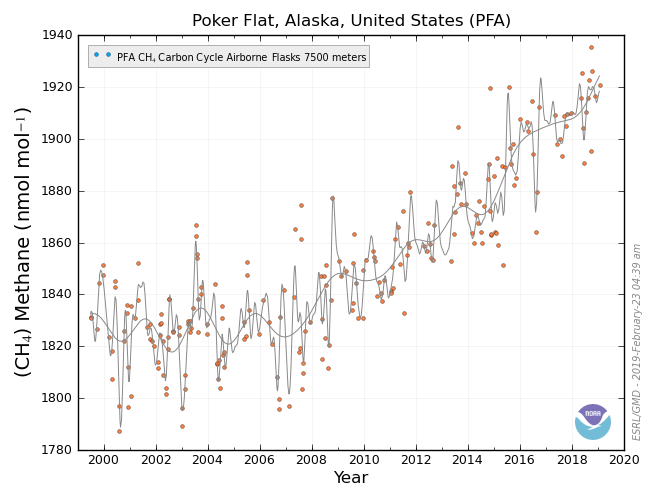
Not really a spike, but they set a new record.
-
That's all fine and dandy, but you never answered my question. Why is Barrow the ONLY location reporting a major spike in CO2 and Methane? You just quoted this :
At the VERY least everyone should be very skeptical that the Barrow reading are accurate. There is no other station that shows even remotely the same reading. The Barrow station rose over 20% it seems in Methane concentrations. If there was that much Methane being pumped into the arctic why is it not showing up at other locations near Barrow? There are some big question marks right now, I'm concerned because if the readings are right then that's a sign of a big problem up there but I'm just not buying it yet. Give me even one more station reporting a rise in Methane like Barrow and then I'll believe.


Barrows air is coming off the arctic fromGreenland, Greenlang, from northern Europe.
The air did not have a methane spike when it left Greenland , but has a methane spike when it gets to Barrow. Looks like the arctic is the source of this methane to me.
The elevated methane has been measured by land air and sea, by three separate programs, the venting has been witnessed.
-
Those ridiculous C4 anomalies are not showing up on any other locations. Why are you do hell bent on assuming the data is accurate when no other locations support a rise of over 20% in concentration. Cold Bay, AK, Nunavut, Canada and the location in Greenland do not show similar data.
"When the AO index is positive, surface pressure is low in the polar region. This helps the middle latitude jet stream to blow strongly and consistently from west to east, thus keeping cold Arctic air locked in the polar region."
http://en.wikipedia....tic_oscillation

This fall we had measurements from a surface vessel and a wide ranging aircraft survey.
The vessel measured "100 times normal", the aircraft:
"Something too new to fully understand (although a report on it is being prepared for publication), Wofsy says, is a finding of notable concentrations of methane in the Arctic’s atmosphere that trace back to the sea."
“We observed that the ocean surface releases methane to the atmosphere all over the whole of the Arctic Ocean,”
http://www.sciencene...imate_surprises
Now, these people will not get their data published until spring. So we should just ignore their warning? What do you want to talk about? 2009? We have lots of published data about that.
-
"Retreat of Arctic sea ice releases deadly greenhouse gas."
Retreating Sea Ice has nothing to do with releasing methane. If you think otherwise...explain how sea ice contains the Methane. This headline should make a thinking person think. "deadly greenhouse gas" These sort of headlines and "studies" really hurt the crediability of those that think this is legit.
A link to a respectable site that shows increasing methane in the Atmosphere would be a start. Previous surveys of methane release would be also needed.

http://www.esrl.noaa.gov/gmd/dv/iadv/graph.php?code=BRW&program=ccgg&type=ts
http://www.sciencenews.org/view/generic/id/334245/title/HIPPO_reveals_climate_surprises
-
Where else do you believe the methane deposits came from? The earth is in a cool period right now and thats the only reason we even have ice caps.

It comes from natural gas deposits. Here in California we have natural gas seepage all over the place. The seepage is generally slow and constant. With a short half life in the air slow seepage is not a big problem. The problem comes when thousands of years of seepage is stored near the surface as a hydrate and becomes unstable causing a rapid, high volume release.
-
The Navy stuff is certainly suspect, followed it in the winter to get flow patterns as opposed to specific data - but the readings you are getting are even lower than theirs. My point was that most of the ESAS is off the charts & that this could be an indication of clathrates breaking up there as we speak.
BTW any idea how they are getting SSS data after freeze up?
The data assimilation is performed using the Navy Coupled Ocean Data Assimilation (NCODA) (Cummings, 2005) system with a model forecast as the first guess. NCODA assimilates available satellite altimeter observations (along track obtained via the NAVOCEANO Altimeter Data Fusion Center), satellite ice concentration, satellite and in situ SST as well as available in situ vertical temperature and salinity profiles from XBTs, Argo floats and moored buoys using a 3-Dimensional VARiational analysis (3DVAR) scheme. For more information about the validation of the ACNFS, see (Posey, et al., 2010). For more information concerning the models see the links below:
http://www7320.nrlssc.navy.mil/hycomARC/prologue.html
"The ocean model temperature and salinity fields are loosely constrained
(Sarmiento and Bryan, 1982) to the Levitus (1982) climatological data set."
-
They will be cast off as crazies. Even if what they believe happens.
Unless they are lying, it is already happening.
They know that, you have to admire their courage. You also have to to believe that they are scared, more for the planet than for their jobs and reputation.
-
An Arctic methane emergency group has been formed, and has set up a web site.
http://www.arctic-me...bout/4558060537
"Letter to the worlds leaders"
"Emergency intervention to stabilize Arctic sea ice and thereby Arctic methane is today a matter of our survival."
http://www.arctic-me...ders/4558749249
Ken Caldeira, Professor of Environmental Earth System Sciences, Stanford University, US;
Ed Dlugokencky, PhD, National Oceanic and Atmospheric Administration (NOAA), US;
Michel Halbwachs, Professor of Physics, University of Savoie, France;
Veli Albert Kallio, Chairman of the Frozen Isthmuses’ Protection Campaign, UK/Finland;
Jon Egill Kristjansson, Professor of meteorology, Oslo University, Norway;
Mike MacCracken, PhD, Climate Institute, Washington, US;
David Mitchell, Associate Research Professor, Division of Atmospheric Sciences, DRI, US;
Brian Orr, PhD, former Principle Scientific Officer, Department of the Environment
Stephen Salter, Emeritus Professor of Engineering at Edinburgh University, UK;
Natalia Shakhova, PhD, International Arctic Research Center, University of Alaska, US;
Igor Semiletov, PhD, International Arctic Research Center, University of Alaska, US;
Peter Wadhams, Professor of Ocean Physics, Cambridge University, UK;
Leonid Yurganov, PhD, Dept of Physics, University of Toronto, Canada.
-
These are all great, but very idealistic in nature. How do you plan on getting everyone to comply by these 12 rules? Also, there is no way China, India, and other developing countries would comply with these regulations, so it is really pretty hopeless for the time being. It is what it is and I don't think CO2 concentration in the atmosphere is going to decline unless the global economy melts down.
The global will will not be there until we get alarmed, shocked, and frightened by an actual threat. An ice free arctic in late summer might do the trick. That will be the climate change Pearl Harbor. After the holidays I am going to start a new topic about this.
-
Back on topic:some interesting reading:
"Fossil fuels are a common source of both ethane and methane. Methane has many other sources, but we know most of the ethane in the atmosphere today is from fossil fuels. If ethane changes, it is easier to figure out the cause" said Aydin. "After carbon dioxide, methane is the second most important greenhouse gas. This research was conducted to track ethane and to see what it could tell us about methane. We found that ethane emissions declined at the same time as the rise in methane dramatically slowed, suggesting a common cause." At the end of the 20th century, methane and ethane were deemed valuable energy resources; collected and consumed as natural gas they are converted to carbon dioxide. The researchers' results for this time frame indicate that the leveling off in atmospheric methane in recent years is likely linked to this change in energy use.
http://www.nsf.gov/news/news_summ.jsp?cntn_id=121363
An abrupt release of methane, a powerful greenhouse gas, from ice sheets that extended to Earth's low latitudes some 635 million years ago caused a dramatic shift in climate, scientists funded by the National Science Foundation (NSF) report in this week's issue of the journal Nature.
The shift triggered events that resulted in global warming and an ending of the last "snowball" ice age.
The researchers believe that the methane was released gradually at first and then very quickly from clathrates--methane ice that forms and stabilizes beneath ice sheets.
http://www.nsf.gov/news/news_summ.jsp?cntn_id=111554&org=EAR&from=news
-
What if "thy neighbor" has 2 Hummers and a 10,000sq. ft. home??? And if they love you just enough to take the bus into work a couple times a week....will he/she be vindicated of their environmental crimes in your eyes, because they indeed have "sacrificed" to an extent? Questions to ponder.....
I just meant that we need to be less concerned about ourselves and more concerned about others. I saw a "so what" posting in response to some very poor people loosing their homes to rising sea level.
I do not think the political will and the money to deal with the problem effectively, until something bad happens. Exxon, the Koch brothers and Rush have run an effective propaganda campaign.


We are loosing the battlefield of public opinion.
-
I don't agree with you but for arguments sake what should we do about it? We warn people and tell them to do what? What are you going to do to stop this catastrophe? How many people are going to die because of this earth shattering discovery?
How long are the deniers and the fossil fuel companies going to dig their heels in and prevent meaningful action?
-
I don't agree with you but for arguments sake what should we do about it? We warn people and tell them to do what? What are you going to do to stop this catastrophe? How many people are going to die because of this earth shattering discovery?
- Declare global war on GHG.
- Invest in sustainable energy: solar, wind, wave, ethanol, hydrogen, geothermal(this will kick the world economy into high gear as a secondary effect.) then:
- stop mining and pumping fossil fuels.
- Go back to returnable reusable bottles, compost able packaging.
- Build durable(1,000+ yr) infrastructure(like the Romans did. Some of their aquiducts, roads bridges, sewers, and buildings are still in use.).
- Use bicycles and walking for routine, local, travel.
- Replant the forests.
- Invest in research in sustainable farming and living.
- Stop dumping chemicals into the environment.
- Stop human population growth through education and economic incentives.
- Back off from the natural world. Have a smaller footprint.
- Love thy neighbor as thyself.
That would be a reasonable start. Its a twelve step program for fossil fuel addiction.
- Declare global war on GHG.
-
Vergent
Well thought out - and disturbing.
A few thoughts:
AGW removes enough ice cover to allow storms to mix the thermocline causing a 3C increase in bottom temperature in the Lapev Sea.
http://www.polarrese...w/6425/html_150
The Laptev is a shallow water body overlaying a permafrost cap beneath which vast amounts of methane are trapped. The warm water increases the permeability of the cap allowing methane to escape.
Most of the methane remains in the water column causing Ocean Acidification as is noted in the Bering Sea off Barrow.
http://www.skeptical...news.php?n=1150
The CH4 being 100 times more powerful as a greenhouse gas than CO2 over a short period, causing temperature anomalies of over 10C in many locations in the Arctic. The buoyancy of the gas causes low pressure zones which bring the melt season to an abrupt end at the earliest date ever recorded.
Much of the escaping methane, being much lighter than the surrounding air, streams up to the Ozone Layer causing the first ever Arctic Ozone Hole. Much of the remainder is forced high in the atmosphere by severe low pressure systems (think ice hurricane), and above the altitude of the sensing stations - except for a small amount registered at Barrow.
Assuming next summer's Arctic ice melt off to be similar to those since 2007 is there any reason to expect this not to continue?
Not sure all the dots are connected and welcome constructive comments.
THIS IS NOT GOOD.
“It is High Time to Warn People”
-
What is it you are trying to show?
The CO2 and Hydrogen measurements are also out of whack.
methane oxidizes in the atmosphere to make CO2. hence the mildly elevated CO2.
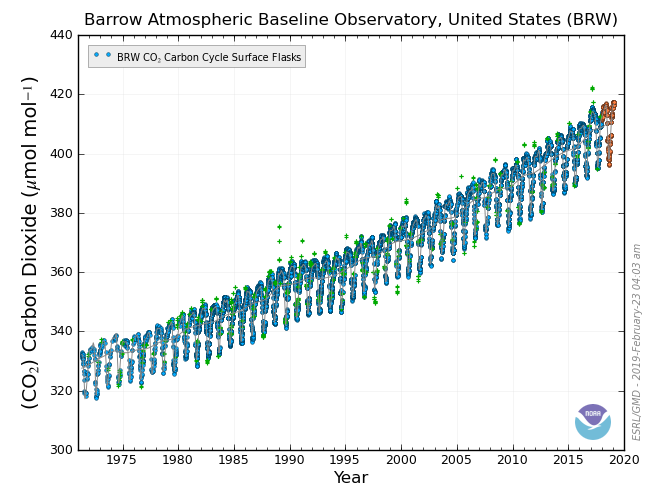
Oxidation of methane involves the hydroxyl radical (·OH) which is highly reactive with hydrogen, hence the mildly lower H2.
"
Oxidation by hydroxyl radicals
Because of its hydroxyl radicals-mediated oxidation reaction, H2 is seen as an indirect greenhouse gas. Indeed, H2 oxidation exerts indirect incidences on methane and ozone concentrations, the latter being two greenhouse gases. Having a hydroxyl radicals-mediated oxidation rate similar to methane,"
http://www.eoearth.o...hydrogen_budget
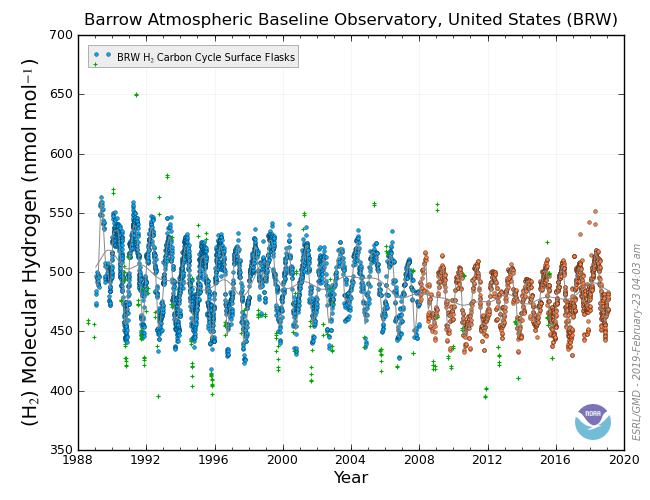
These readings are consistent with each other: Elevated methane, elevated methane oxidation product(CO2), co-oxidation of hydrogen. Since they have similar rate constants the CO2 gain and the H2 loss should be equal, they are.
Nothing is out of whack.
-
What is it you are trying to show?
I'm showing that there is nothing wrong with the equipment at Barrow. SF6 is the least noisy gas they monitor. Barrow is in perfect agreement with the Greenland station.
By the way mass spec is one of the most accurate measurements in science, it counts molecules. You get as many significant figures as you want.
-
The Barrow readings are probably incorrect. Other atmospheric measurements from the station are out of whack as well.
It is generally wise to be suspicious of such anomalous readings.
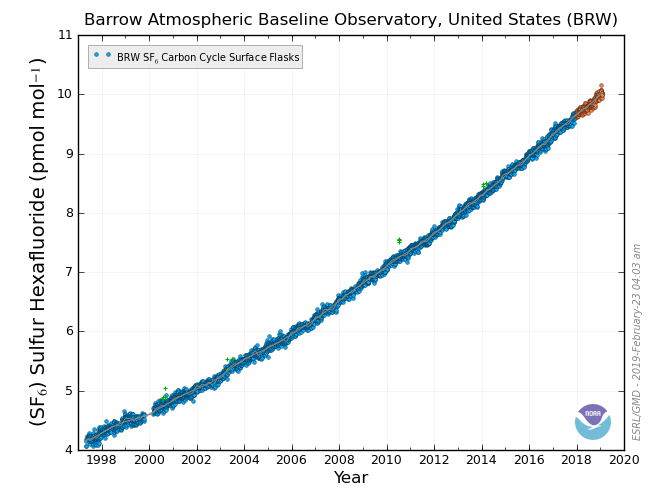
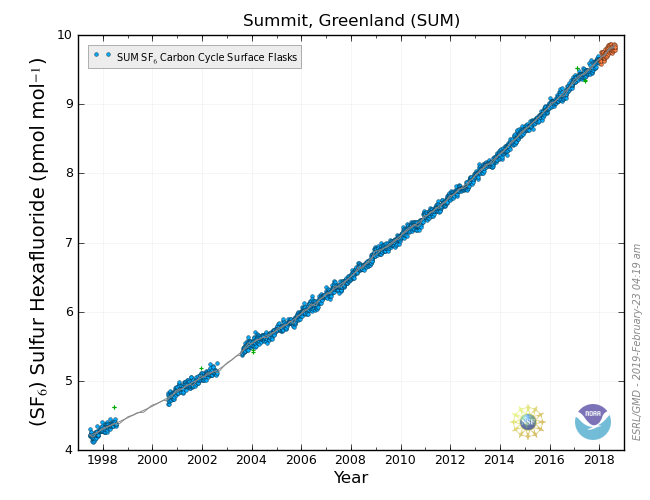
The barrow mass spec is clearly bonkers.
-

More elevated methane measurements at Barrow. It still has'nt shown up else where, but AO+ traps air in the arctic.
-
Thank you so much for posting this. I am glad to see oxy production was up in the southern hemisphere. But the rest sucks.
Have to give TerryM the credit, he linked to the article first, I missed his post.
-
An interesting post at
http://theidiottrack...le-of-tape.html
promises more from Semiltov and gives an assessment of his work vs Dmitrenko's
Thank you so much for the post. Well reasoned article. There is a good laugh at the end. But it is graveyard humor...
-
So this is a mostly a laptev and ESB event or kara and chuchki to barents and bearing.
Also, my cpu is broken. I am getting it fixed this week. Will someone please post any real time obs of ch4 in the arctic region, thank you.
There has been independent widespread measurement of elevated methane in the arctic.
"Something too new to fully understand (although a report on it is being prepared for publication), Wofsy says, is a finding of notable concentrations of methane in the Arctic’s atmosphere that trace back to the sea.
“Oceanographers have known for some time that there is production of methane in surface waters of the Arctic,” he says, but “it’s never been observed in the atmosphere.” Those oceanographic data, he says, suggest a source for this methane other than sediments or the melting of icy gas hydrates.
The phenomenon also appears very widespread. “We observed that the ocean surface releases methane to the atmosphere all over the whole of the Arctic Ocean,” Wofsy says."
http://www.sciencene...imate_surprises
This is not good.
-
How do you know that what they recently reported in the Independent has not been going on for a while now and there still
is no dramatic increases in methane? What makes them think that this something new and just not newly observed?
Did you read the article?
" the Russian research team who has been surveying the seabed of the East Siberian Arctic Shelf off northern Russia for nearly 20 years."
" Igor Semiletov, of the Far Eastern branch of the Russian Academy of Sciences, said that he has never before witnessed the scale and force of the methane being released from beneath the Arctic seabed.
"Earlier we found torch-like structures like this but they were only tens of metres in diameter. This is the first time that we've found continuous, powerful and impressive seeping structures, more than 1,000 metres in diameter. It's amazing,"
-
http://www.agu.org/p...1EO490014.shtml
Siberian shelf methane emissions not tied to modern warming
Colin Schultz
American Geophysical Union, Washington, D. C., USA
Eight thousand years ago, a rising sea inundated the vast permafrost regions off the northern coast of Siberia. Comprising the modern east Siberian shelf, the region holds enormous quantities of methane hydrates bottled up in remnant subterranean permafrost zones that are, in turn, trapped beneath the ocean waters. Records of seafloor water temperature showing a 2.1°C rise since 1985, coupled with recent observations of methane emissions from the seabed, have led some scientists to speculate that the rising temperatures have thawed some of the subsurface permafrost, liberating the trapped methane. The connection is compelling, but an investigation by Dmitrenko et al. into the sensitivity of permafrost to rising temperatures suggests the two observations are not connected. Using a permafrost model forced with paleoclimate data to analyze changes in the depth of frozen bottom sediments, the authors found that roughly 1 meter of the subsurface permafrost thawed in the past 25 years, adding to the 25 meters of already thawed soil. Forecasting the expected future permafrost thaw, the authors found that even under the most extreme climatic scenario tested this thawed soil growth will not exceed 10 meters by 2100 or 50 meters by the turn of the next millennium. The authors note that the bulk of the methane stores in the east Siberian shelf are trapped roughly 200 meters below the seafloor, indicating that the recent methane emissions observations were likely not connected to the modest modern permafrost thaw. Instead, they suggest that the current methane emissions are the result of the permafrost's still adjusting to its new aquatic conditions, even after 8000 years. (Journal of Geophysical Research-Oceans, doi:10.1029/2011JC007218, 2011)
In order be published now this article had to be submitted last spring i.e. It is based on last years data.
So, what this article is stating is that the 8 megatons emitted last year, was not primarily the result of warming. But that is 0.01% of what is being observed this year. What is causing the other 99.99%?
Also, this study is a model based. This model indicated that eruptions like the ones reported can't happen. Either the model is in error, or someone is telling a career ending whopper of a lie.
Who is Colin Shultz? "I am a science journalist"
http://colinschultz....ress.com/about/
We have run into him before. Remember "No tipping point for Arctic Ocean ice" He does have a masters in journalism. No post graduate science degree.


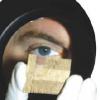
This is not good.
in Climate Change
Posted
For those who are complaining that more stations are not detecting the methane, this is how narrowly distributed a localized emission is(in this case ash). We are lucky to have caught a whiff of it at Barrow.